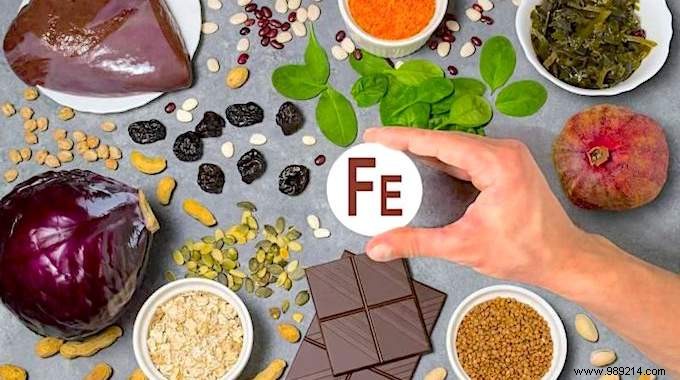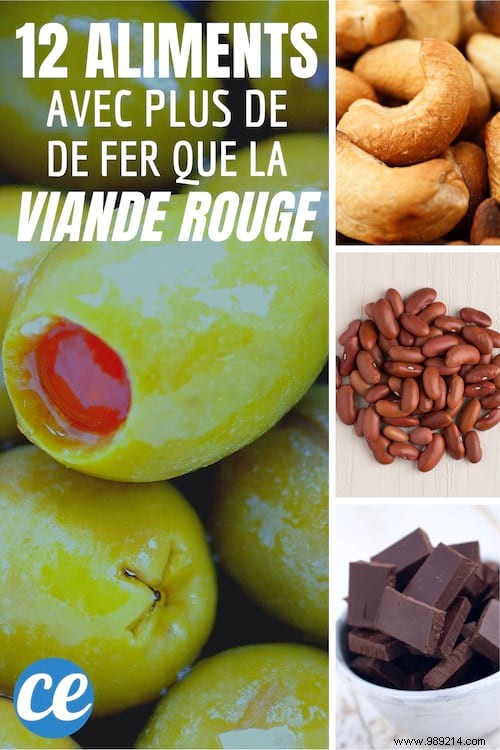
Feeling tired? And do you have headaches?
This may be a sign of iron deficiency...
If you don't eat enough, you risk anemia and you can feel it in concrete terms:fatigue, headaches and cascading infections...
In short, you might as well protect yourself by stocking up on iron. Generally, we turn to red meat and offal.
But did you know that some plant foods contain much more iron?
To refuel, here is the list of 12 foods richer in iron than red meat. Watch:

With 66mg of iron per 100g of product, it is the queen of spices. Curry (29.7 mg) and cinnamon (8.3 mg) also have a nice iron content.
So obviously, you can't consume so many spices all at once.
But sprinkled here and there in your dishes, spices will make a difference in your iron level.
Moreover, in addition to delighting you, they have many other virtues recognized for centuries.
They help digestion and relieve heartburn. They are also antioxidant and anti-infectious.
Fresh or dehydrated, we know this aromatic herb that smells good in summer.
Well, in addition to being so fragrant, thyme is rich in iron with 30 mg per 100 g.
Thyme is also to be used to fight against minor everyday ailments.
It is particularly effective against anxiety, cough and bronchitis (to be drunk infused in herbal tea), dental plaque (to be taken infused in a mouthwash), inflammation of the skin (to be used crushed in a poultice).
And of course, it is to be consumed all year round, in our good little dishes, while doing us good.
To discover: The Virtues of Thyme, a Plant that Should Come Out of the Kitchen.
We've heard a lot about this freshwater algae in recent years... with good reason!
Rich in vitamins and minerals, it contains 28.5 mg of iron per 100 g and is easily assimilated by the body.
It is consumed in the form of powder or capsule, available in organic stores and herbalists.
In addition to iron, spirulina allows you to fill up with trace elements, minerals, but also omega 6 and chlorophyll.
To discover: Spirulina:10 Health Benefits Everyone Should Know.
Sesame is not only a superfood in terms of iron!
It also provides many vegetable proteins and trace elements:magnesium, calcium, potassium, zinc, and phosphorus.
Deliciously scented, it will also make your soups and salads delicious and give pep to your savory and sweet dishes!
You can find it in the form of seeds of course, but also in oil and puree (tahin).
We all know this little seed, which is consumed in a whole host of forms.
Fresh or canned bean sprouts, cream or soymilk, seitan and, of course, tofu which comes in many flavors.
It is not for nothing that soy is so popular around the world!
Cheap, it is rich in iron, protein, but also in unsaturated fats.
These are "good" fats, which are to be preferred, unlike the so-called unsaturated fats contained in products of animal origin and which we tend to abuse on a daily basis.
To discover: The 6 Main Benefits of Soy Milk.
This is THE good news of this ranking!
Indeed, eating chocolate is recommended for good health and energy.
One condition:it must be dark, with at least 70% cocoa, organic if possible.
In addition to its richness in iron, it maintains our arteries and our cells by fighting against their premature aging.
In addition, dark chocolate is an excellent source of magnesium, necessary to keep in shape and in good spirits.
So, frankly, why would we deprive ourselves of it?!
To discover: Do You Know the 5 Health Benefits of Chocolate?
The benefits of oleaginous fruits (hazelnuts, macadamia nuts, pistachios, almonds) are widely recognized.
They are a source of complex lipids and monounsaturated amino fatty acids (the "good" fat, also contained in a good extra virgin olive oil).
The advantage of the cashew nut is that it adds to these virtues an iron rate almost twice as high with 6 mg per 100 g.
Consider snacking on a small handful of cashews or other oilseeds during the day or chopping some in your salads and casseroles.
If you take them organic and without added sugar or salt, your body will say "thank you"!
Widely used in Mediterranean or Eastern European cuisine, these small seeds are as tasty as they are good for your health.
Calcium, fibers, proteins, complex lipids, carbohydrates...and iron of course!
You can either snack on them as they are...
...or put it in your salads, your sautéed vegetables, your pastries and in your sauces.
These small seeds do not only have a very interesting iron rate!
They are also rich in polyunsaturated fatty acids, which are good for the health of your skin, your hair and your arteries.
Their fibers also facilitate capricious digestions.
Moreover, like dark chocolate or pine nuts, it is a significant source of calcium, magnesium...
...but also deliciousness in everyday cooking!
This very gouty legume contains a high level of iron, especially since it is easy to consume in our cooked dishes.
Just remember to soak them well in cold water before cooking, to make them more digestible.
In addition, red beans help regulate diabetes and reduce cardiovascular risks.
Little tip:like sesame, red bean paste is creamy and really delicious.
It can replace the butter in your cakes and thus make them less fatty.
Also remember to add it to your sandwiches and vegetables, as if it were a condiment.
To discover: The Friendly and Inexpensive Chili Con Carne Recipe.
One of the best-known sources of vegetable protein and iron:lentils.
Their fiber content also makes them a highly digestible food that should not be deprived.
Blonde, green, black, small or plump, lentils are appreciated by young and old.
They go perfectly in a salad, with a little mustard vinaigrette, or in a hearty dish accompanied by root vegetables.
To discover: The Friendly and Cheap Recipe for Sausages with Lentils.
The Cretan diet sounds familiar to you, doesn't it?!
Yes, the other ancestral product with notorious virtues is the olive.
It too comes in different shapes, colors and scents.
In addition to its 3.3 mg of iron and its complex fatty acids, the olive combines multiple benefits:prevention of cancer, cardiovascular disease and hypertension...
...but also reduction of the harmful effects of pollution on our organism.
So, more than ever, to fill up on energy and be in good health, let's give southern colors to our daily lives!
To discover: How to Store Green or Black Olives?